Abstract
This paper presents an historical analysis of developments for the creation and usage of models of mechanisms in academic teaching fields, with the aim of re-evaluating the interest and usefulness of models in teaching and research, and of promoting their merits as a cultural heritage worthy of being preserved. The historical analysis is focused on developments in Italy, with specific attention given to physical models created and used for training young engineers in Italian engineering schools, using commercial products, but also original Italian creations. Examples are reported from the main Italian academic sites, where examples of such models of mechanisms have been preserved or have survived, also, as first attempts at museum valorization in terms of historical memorabilia of educational developments on mechanism design issues.
1. Introduction
Modeling, which can be understood as the conceptualization of structural and functional characteristics, was and still is the basis of any analysis and design procedure, especially in mechanical engineering. In particular, the development of mechanical machinery, both in theory and in practice, has been and continues to be based on the development of appropriate models of various forms and insights. Usually, in the history of mechanical engineering and machines, no reference is made to the history of models, even if they are used mainly in the form of graphical solutions to illustrate the evolution of knowledge and design solutions, that have had an impact on both science and technology in a broad spectrum, such as, for example, in encyclopedic treatises [,], and bibliographic overviews []. In the history of machine science and technology, models have had a rapid development, especially during the Industrial Revolution, as demonstrated by the numerous cabinets and exhibitions that were created in various locations, and especially in Europe []. Furthermore, specific attention given to the models of machines and mechanisms reached widespread and professional credibility with the work of Franz Releaux [], who, in the second half of the 19th century, created a set of models of mechanisms for didactic use [] through the Voigt company, obtaining global success, which is demonstrated by the fact that examples of his commercial collection are still present in many academic sites and museums across the world. In the same period, there were also local initiatives for the development of models of mechanisms, such as the collection of mechanisms at the University of Dresden, Germany [], and at the Bauman Polytechnic, Moscow [].
With the aim of refreshing attention to this technical and cultural heritage, this work presents models of mechanisms collections from Italian academic fields, which have had, and still have, not only technical but also historical interest. In general, examination of the historical development of Italian models of mechanisms has not been specifically addressed as far as can be understood from the few publications available, especially with regard to recent papers, that have, for example [], reported technical-historic re-evaluation studies of these collections. In this work, the focus is on Italian initiatives and experiences, referring to the main historical sites of engineering schools in Italy in order to outline an historical interest, and to characterize the development of models of mechanisms as a cultural, and not only technological heritage, that can be considered of public worth and therefore deserves to be preserved and made usable, as highlighted in [,,,].
2. Consideration on Models
A mechanism is defined in the IFToMM terminology [], as “Constrained system of bodies designed to convert motions of, and forces on, one or several bodies into motions of, and forces on, the remaining bodies”. From a teaching viewpoint, as stated in several textbooks worldwide, for example [,], a mechanism is defined as a set of rigid bodies in the form of links, that are connected to each other with the purpose of converting the mechanical energy given to an input link into mechanical energy with a different value in the output link. Thus, a mechanism is used for its capacity in motion and force transmission, as a motion generator or action generator, respectively. In this way, a mechanism can be a fundamental component of machine design for its function in elaborating mechanical energy at proper levels, according to a machine task.
Consequently, a mechanism can be modelled by a scheme of its structure and operation parameters, with graphical drawings and/or mathematical formulation that can be used for performance analysis and operation simulation of the tasks, for which the mechanism is designed and operated. In general, a model can be a simplified representation of a system, and in the case of mechanical systems it is an abstract representation of the mechanism structure with its main mechanical features and parameters, so that it can be useful in teaching, design, and advertising through different modes, as outlined in [].
Because of the above considerations, the modelling of a mechanism can be useful not only for design purposes but also for analyzing the mechanism working with its peculiar performance. Thus, a mechanism model can be created for design, simulation, and testing purposes with solutions that today range from virtual representations in computer-oriented software packages, to scaled simplified mechanical constructions, including prototypes or demonstrators, when referring to the same model as an evolution of a design solution.
As mentioned above, in general, mechanism models are useful and indeed used in several kinds of activity in teaching, study, investigation, design, demonstrative exhibitions, simulation, testing of operation characteristics, experimental validations, and even promotion and marketing publicity. They are also used as a means for design and construction of mechanical systems, and as tools or system components in activities for other engineering subjects with similar goals or complementary actions, as outlined in [], referring to service operations.
Today, mechanism models are created as sketches or drawings (by hand or using computer-graphics apps); by mechanical constructions in either reduced sizes or prototypes; and in virtual computer-based solutions using different software with visualization for human interaction. Figure 1 summarizes the historical evolution of mechanism, indicating solutions that are linked to the progress of technological tools [].
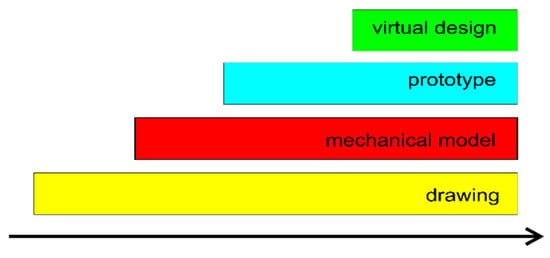
Figure 1.
A timeline of conceptual evolution of mechanism models [].
In Figure 1, the ‘drawing’ type of model refers to a graphical scheme that, since Antiquity, was produced as a pictorial representation with several other details. Even today, first design concepts are outlined with sketches (by hand or by graphics software), which are considered the first results in formulating and designing mechanical solutions, or in expressing concepts and solutions. A graphical drawing model can be produced in several different formats, with several different levels of accuracy in terms of graphical expression, as used in several disciplines other than mechanical engineering. Over time, drawing models have evolved from base-line abstraction, to naturalistic scenarios, and up to technical drawings with standardized rules (see, for example, isometric views and cross-sections with standardized colors for material and lines), such as, for example, in the representation of gear designs []. Indeed, the technical drawing technique is established with standards such as drawing rules, so that teaching activity can be planned for specific courses. In practically all engineering curricula, and mainly in the first year of study, the significance of the drawing tool in learning and explaining technical machine designs is a fundamental topic.
The second type, ‘mechanical model’, as seen in Figure 1, indicates mechanical constructions that can be a prototype of machine design or construction for experiments of phenomena still under investigation and in need of explanation. During the historical evolution of science and technology, mechanical models were extensively used before other more significant activities. Since today’s prominence of informatics development, they have again acquired significant attention in teaching and research activity, mainly when prototypes are used in developing machine products. Thus, a mechanical model is again expressed with a mathematical formulation emphasizing mechanical features, in order to be used in reiterated design solutions and in teaching characterization of design parameters and operation performance.
A ‘prototype’ is the third type of model as seen in Figure 1, and is intended to be a mechanical-built solution that can be realized in different size scales. A prototype is produced as a first design, before a final solution of a product, and it is often considered as a tool within the design process to validate operation and performance, before having the final product ready for manufacture and production, and/or before proposing it to the market, or to the invention intellectual-protection process. Prototype models are extensively used in the design process for determining machine functionality; this may require analysis of a machine divided into subsystems devoted to specific aspects. For example, the design of a car engine can be organized with mechanical, electrical, and thermal parts, and for each of them a specific prototype can be considered within the design process.
Mechanical models and prototypes require efforts in manufacturing and processing, however, an understanding of computer science is useful for ‘virtual design’ models, that are designed, operated, and experienced virtuality with systems ranging from simple CAD designs up to sophisticated, haptic 3D simulations. Today, virtual models are widely implemented in the design process and teaching, and are produced following previous solutions based on modelling or drawing. Although not explicit, drawing modelling was a necessary development. The virtual model approach in Figure 1 is useful for functionality analysis and for finalizing product design, with considerations of durability and economic convenience by evaluating the effects of multidisciplinary and component integration in several applications, such as advertising, study, design, and teaching. Thus, virtual models can also be considered to be a representation of other types of models, such as modern expressions of significant content within science and technology, and also in the history of mechanical engineering. As a value of cultural heritage, it is recognized as being worthy of being preserved, thanks to its design concepts (in graphical or mathematical formats) and product features. A virtual model is a fruitful means of preserving intangible aspects of cultural heritage when original solutions cannot be properly expressed, so that they can be used to show the historical evolution of knowledge and be a source for further developments.
As summarized in Figure 1, mechanism models were, and still are, created in different formats for different aims, within activities such as teaching, analysis, design, experimental activity, and historical investigations, and they may still pay a key role not only in mechanical systems, but in other technical and scientific activities.
3. A Short Account of Italian History of Mechanism Design
In Italy, the Industrial Revolution occurred during a period of national unification in political, social, and cultural aspects, with events that also affected academic research and training programs, as summarized in [].
During the first half of the 19th century, Italy still suffered significant political fragmentation, which also affected curriculum teaching, with different plans in each state. After political unification was achieved, the standardization of university programs was planned as a priority, in order to achieve a cultural unification. This required robust plans and significant adjustments in most Italian universities, especially with regards to the programming curriculum content given by teachers, who often worked in more than one university. In addition to restructuring activity, the Italian academic communities, and particularly those working in mechanical engineering, made significant contributions to Italian industrialization with regards to technical-scientific achievements, and in the organization and support of entrepreneurial initiatives.
During the first half of the 19th century, following advances of the metallurgical industry, the first significant industrialization initiative was developed in Southern Italy, within the organization of the Kingdom of the Two Sicilies, for the production of civil constructions and infrastructures, steam engines, and several types of industrial machines. While this first excellent achievement is recognized today, as briefly outlined in [], the academic support of those industrial initiatives is still not well known, particularly when referring to specific figures who were not only devoted to theoretical investigations and fundamental mechanical designs. At the same time, in Northern Italy, universities activated specific programs on the mechanics of machines, recognizing the significant value of scientific formation for the nascent industrial frame, as a result of more contact with neighboring industrializing European countries. Examples of this can be considered the milestone work of Giuseppe Antonio Borgnis [], who was formed at the Ecole Polytechnique, Paris, while also being professor at Pavia University from 1818 to 1821, and who published his famous 9-volume handbook on machines, that included the first technical dictionary on machines. Another example is the milestone work by Carlo Ignazio Giulio who, at the same time as Willis’s work, published the first Italian textbook Theory of Mechanisms []. One more example of northern prolific theoretical activities is the work by Gaetano Giorgini who formed at Ecole Polytechnique, Paris, while working in Modena elaborated the first modern investigation [] on the theory of screw (general helicalicoidal) motion of rigid bodies, with a postscript note on the 1763 book by Giulio Mozzi.
Even more significant are works and achievements in the second half of the 19th century, because of the cultural unity of academic frames that was organized and consolidated through the Royal Application Schools for Engineers in the main universities, which further supported the maturity and growth of industrialization initiatives. In the formation curriculum of industrial engineers, Mechanics Applied to Machines was planned with a central role, as it was in all the European universities; later, the augmented discipline of Kinematics Applied to Machines was recognized as mandatory for all curricula of industrial engineering at ministry level, with the Decree of 3 July 1879.
The university sites were in Turin, Milan, Bologna, Rome, and Naples. Domenico Tessari (1837–1909) and Scipione Cappa (1857–1910) were active in Turin. It is also worthy to note that Elia Ovazza (1852–1928), who moved to Palermo in 1890, successfully started a significant center there, including a laboratory which is still of historical interest today []. In Milan, Giuseppe Colombo (1836–1921) and Ugo Ancona ((1867–1936) were significant figures in mechanical engineering at the time. In Bologna, Giuseppe Barilli (1812–1894) and Francesco Masi (1852–1944) were similarly very active and well reputed. In Rome, the field was developed by Valentino Francesco Cerruti (1850–1909) and Carlo Saviotti (1845–1928). Fortunato Padula (1815–1881) and Ernesto Cavalli (1852–1911) worked in mechanical engineering in Naples, where Giovanni Battaglini (1826–1894) and Dino Padelletti (1852–1892) paid particular attention to more theoretical subjects. Emblematic is Ernesto Cavalli (1852–1911), who simultaneously worked as a teacher in Milan, Livorno, Pisa, and Naples, with the clear purpose of promoting common plans for teaching the subject of Mechanism Design.
Those academic works also stimulated initiatives for new companies since several graduates also initiated industrial activities with the help of their teachers, for example, in Milan, as discussed in []. Also prominent were Giuseppe Colombo, Francesco Masi and Lorenzo Allievi (1856–1941), as emblematic examples of the cultural prolificacy and success of the formation of Mechanics Applied to Machines, with a large range of applications: Colombo was a strong promoter of the industry, as documented in the Italian technical handbook (still in use today, with modern editions), with direct entrepreneur action even at governmental levels when he was a politician with important ministerial positions; Masi was a rigorous teacher who classified the variety of mechanisms, as well as designing the innovative machines for practical implementation []; Allievi, who was based in Rome, developed the milestone work [] on the kinematics of machines, which is still of interest today []. Later, Allievi applied his skill in the management of industrial plants while considering the technical problems of the water hammer in hydraulic engineering, which he solved practically and theoretically, with a theorem ascribed to him [].
After the First World War, Mechanics Applied to Machines was confirmed as being of primary significance as a driving technological development, and was given a central role in the formation programs of technicians and of all engineering professions. Between world wars and during wartime, activities were carried out intensively but with very limited dissemination. Nevertheless, achievements were fundamental for advances during wartime, and at the start of the post-war booms. The major university sites before 1940 were still located in Turin, Milan, Bologna, Rome, and Naples. Modesto Panetti (1875–1957) was in Turin. Ugo Ancona and Igino Saraceni were in Milan. Aristide Prosciutto (1895–1954) was in Bologna. In Rome, Anastasio Anastasi (1877–1969) was the main teacher. In Naples, activities were coordinated by Giovanni Domenico Mayer (1868–1925). Other significant activities were in Pisa, carried out by Enrico Pistolesi (1889–1968), and in Genoa, by Agostino Antonio Capocaccia (1901–1978).
Teaching teams, which were growing in member numbers and works, were active in the most university sites; in 1940 they were present in all universities with engineering schools, such as in Turin, Milan, Genoa, Padua, Bologna, Pisa, Rome, Naples, and Palermo. In the 1950s, new schools of engineering were started in Cagliari, Trieste, and Bari, with teachers in Mechanics of Machinery. Interests spanned from today’s traditional subjects of the Theory of Mechanisms, linked to analytical and rational mechanics, to more challenging fields referring to the design and development of mechanical systems for industry and services. Specific attention was given to new subjects related to aeronautic systems, aerodynamics, biomechanics and medical devices, fluid dynamics, industrial automation, machine regulation, and finally robotics, with achievements and designs that were among the most advanced in the world. Industrial mechanical engineering was also improved by this vivacity and cultural prolificacy, with achievements in applied research and even with the formation of creative professionals and industrial managers. A brilliant example is Corradino D’Ascanio (1891–1981), who spanned design skills from mechanical industry to aeronautics and transport vehicles, referring to his pioneering helicopter designs and Vespa scooter by Piaggio []. All of these Italian activities produced significant literature in national and international frames, both for teaching and research, with textbooks, such as those indicated in [], edited books, journals and conference papers. Even today, there are major Italian university teams working in Mechanics of Machinery in Turin, Milan, Padua, Genoa, Bologna, Rome, Naples, and Bari.
4. Modern Italian Mechanism Models in MMS Teaching
The modern teaching of the Mechanisms and Machine Science (MMS) in Italy dates back to post World War II. In this period, we witnessed the establishment of modern universities, a subdivision of knowledge into organic courses, and a formalization of the proposed contents. In Italy, the courses dedicated to the theory of mechanisms and machines take the name of “Mechanics Applied to Machines” (sometimes also known as “Machine Mechanics”, “Applied Mechanics”, “Mechanics Applied to the Arts”), with content that has remained substantially unchanged to the current day.
The structure of the applied mechanics course can normally be considered to be divided into two main parts: the Theory of Mechanisms and the Kinetics of Machines. In the first part, the machine elements and mechanisms are considered from a purely geometric aspect, that is, their kinematic composition and the transformation of movements with procedure for Kinematics and Dynamics Analysis of the mechanism functioning in theoretical and practical aspects. In the second part, aspects of the transformation of energy are considered, referring to the specific design of machine elements with the aim of determining optimal operating conditions. Often, the kinetics of machines includes a relevant part of metrology, for example, for the measurement of friction or mechanical work, which nowadays has taken on its own identity in separate specific courses.
As an example, we can consider the textbook written by Modesto Panetti, which is organized in three volumes. The index of the textbook probably covers most of the contents, which is addressed in the course of Mechanics Applied to Machines in most Italian universities in those years (few differences can be recognized in the theory dealt with, and in the application examples that are characterized as functions of the individual universities []).
- Volume 1: Kinematics of machines. Friction resistance and resistance of the medium. Elementary friction and lubricated pairs. Rolling pairs. Vibrations.
- Volume 2: Gears and wheels.
- Volume 3: Flexible organs. Funicular machines. Cableways. Transmissions with belts.
From the above list, it follows what are the main mechanisms, whose models were made for teaching purposes.
The development of Models of Mechanisms for teaching is aimed at providing a practical example of the theoretical models that are introduced during the course, so that a student can better understand the operating principle of a mechanism, mainly referring to the kinematics of the motion and force transmission. From this point of view, the models are an integration only to the technical drawings in textbooks, which, due to their two-dimensional nature, can generate difficulties in student understanding. Finally, note should be given to the application-professional nature of the teaching that was expected for a degree in engineering, and in particular for a course in machine mechanics. The first models used in universities in Italy were made of wood, as it was cheaper than metal and lighter to transport to the classroom. The models followed the well-established classification of the mechanisms as proposed by Franz Reuleaux [], and the subsequent elaborations of Carlo Giulio [] and Francesco Masi [,,], to cite two Italian significant contributors, as outlined in []. The main models refer mainly to:
- Linkage mechanisms
- Cam mechanisms
- Gear train mechanisms
- Friction based mechanisms
- Wedge mechanisms
- Screw mechanisms
- Belt and chain drives
- Mechanism, containing pressurizing medium
- Step mechanisms
As an example, Figure 2 shows the comparison between a drawing in the treatise of Masi [], and the corresponding wooden model of a cylindrical cam disk, still existing in Bologna. According to the description by Masi: “The figure represents an eccentric in which the line is double curved and is placed on a cylindrical surface; hence the eccentric is also called cylindrical cam. By rotating the cam around its axis, the temple moves alternately in a direction parallel to the axis of rotation. The chain is closed by force by the action of a spring” [,]. By means of the knob on the cam axle, a student or a teacher can rotate the cylindrical cam with a continuous motion and observe the alternate motion of the output rod.
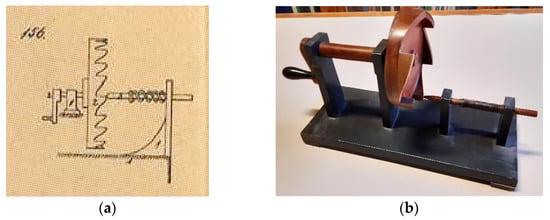
Figure 2.
A model of lylindrical cam disk: (a) in the treatise of Masi []; (b) the corresponding wooden model at the University of Bologna.
Sometimes, the models have more than one input as in the double Hooke’s joint, shown in Figure 3. The input and output shafts can be rotated with respect to the middle one, to show students the relationship between speed ratio and the input/output angular misalignment. Indeed, the model of the mechanism allows a quick and easy demonstration of the theory behind the simple drawing in Figure 3a.
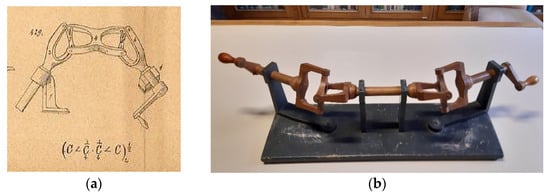
Figure 3.
A model of the double Hooke’s joint: (a) in the treatise of Masi []; (b) the corresponding wooden model at the University of Bologna.
More recently, plastic materials have been used for models, such as bakelite or plexiglass. The advantages are for lighter and cheaper models than wooden ones, especially for planar mechanisms that can be obtained from the processing of plastic sheets. Figure 4 shows the model of a Geneva drive at the University of Bologna: an intermittent mechanism made by five bodies, namely the drive wheel (red), the crank (yellow), the rocker arm (green), and the driven wheel (white). The left extreme of the rocker arm is connected to the drive wheel, while there is a pin on the right one that engages in the slots of the driven wheel.
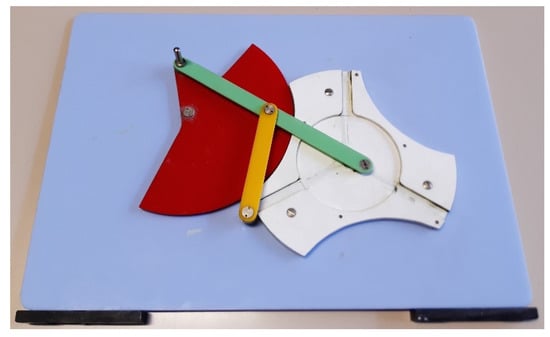
Figure 4.
Intermittent mechanism model made of colored bakelite at the University of Bologna.
Iron models, more expensive than the previous ones, are often used to show the complexity of a real machine rather than a specific mechanism. They are models with cutaways to reveal the internal components. More realistic than previous types, these models are intended to show the real components that are the result of different types of analysis, such as the cooling fins of an engine, which have implications in the thermal analysis but not in mechanical ones. Figure 5 shows a model of the iconic motorcycle, Lambretta, a 2-stroke single-cylinder engine, piston, head and crankcase made of aluminum alloy with a cast iron cylinder. The engine is part of the collection at the Museum of Engines and Mechanisms of the University of Palermo [].
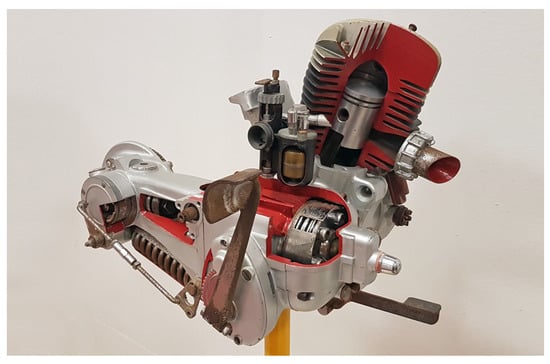
Figure 5.
Engine of the Innocenti motorcycle, Lambretta 125 C (1950–1951) at the Museum of Engines and Mechanisms, University of Palermo.
With the birth and diffusion of computers for personal use, the continuous increase of computational performance and decrease of the costs of the processors, 3D graphics software codes can be made available to universities and students. These 3D CAD software packages allow the modeling of rigid bodies, to assembly several bodies to model a complex mechanism, and to perform multibody analysis, combining Kinematics and Dynamics. This is the birth of the first virtual models of mechanisms: for the first time it is not possible to take in hand or weigh a mechanism model, but its details can be observed through a graphic model on a screen The advantages are the elimination of production costs (with the exception of costs related to the software license), the reduction times of model realization, the possibility of sectioning views to show the contents of an assembly, or to create an exploded view of the component. From the didactic point of view, a student can easily modify or scale the parametric CAD model to finally appreciate the different resulting kinematic behaviors. To date, the main software manufacturers offer integrated solutions, to develop the design phase of the mechanism, the kinematic analysis, the dynamic analysis, and resistance tests in the same pc environment. On the other hand, with virtual models, more practical aspects such as inertial effects or frictions are lost, together with the reality of the mechanism structure and operation with all its aspects. Figure 6 shows an example of a three-speed gearbox model that was developed in Solidworks environment by two students at the University of Ferrara [].
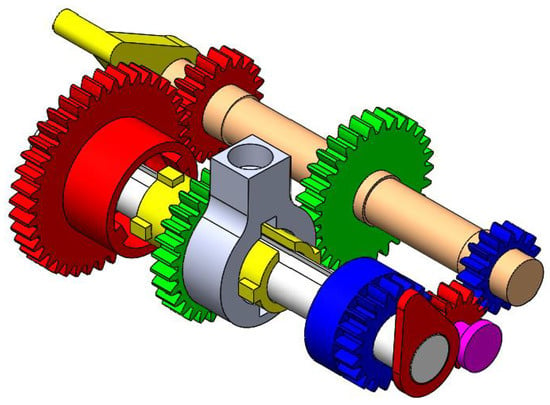
Figure 6.
CAD model of a three-speed gearbox at University of Ferrara [].
Today, the possibility of building educational models is within everyone’s reach, thanks to 3D printing and the concept of additive manufacturing. Fused deposition modeling (FDM) printers of materials such as PLA and ABS are used by makers and hobbyists, and could easily be adopted by universities to model complex mechanisms and machines. Figure 7 shows the model of a V8 engine that was developed as a final project by a Bachelor student at the University of Ferrara. The model has been designed in a CAD environment (Solidworks) and printed in ABS (Makerbot Replicator 2X) [].
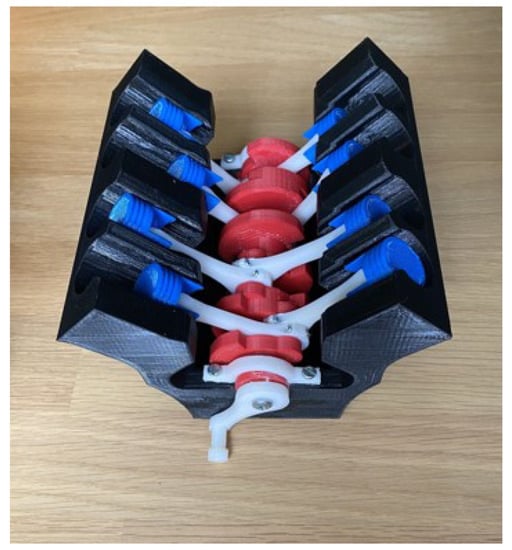
Figure 7.
Construction of a V8 engine model by 3D printing at University of Ferrara [].
Examples are discussed in the following sections to better explain the above concepts, and to show cases that can be of inspiration for further research work on landmarks of MMS heritage, referring specifically to Italian experiences.
5. Mechanism Models for Museum Valorization
Recording past developments and achievements is recognized as having archival value for clear identification of subjects, communities, and people, and is today evaluated as being heritage and worthy of being preserved for understanding the past by future generations. This is what is identified as cultural heritage, which is useful not only for museum preservation and exhibition, but for tracking and maintaining the memory of human evolutions [].
In technical areas, this attention to past achievement is identified in the discipline of History of Science and Technology, which also includes the History of Engineering, with a large variety of topics and interests. The specific History of Mechanism and Machine Science (MMS) is focused on historical developments in MMS; only recently was it considered as part of historical technical-scientific subjects, though with strong technical contents for memory purposes when MMS inventors and scientists are recognized, and engineering procedures and theories are recorded. Nevertheless, MMS historical value seems not to be yet fully recognized within technical cultural heritage, since most MMS achievements are not fully available and understood by the wider public; therefore, historical awareness is still limited within the specific technical community, as stressed in [,].
Indeed, cultural heritage is usually indicated as “the legacy of products of human ingenuity in the form of physical artifacts and intangible attributes of a group or community that are inherited from past generations, are maintained in the present and are preserved for the benefit of future generations”, as stated in UNESCO documents []. Thus, physical, or tangible products, with cultural heritage value are buildings and historic constructions like monuments and artifacts, so that they are suitable for future preservation. These products can be objects in their full state or only remains that contain significant aspects related to the archaeology, architecture, science or technology of a specific culture, with socioeconomic, political, ethnic, religious, and philosophical impacts on people with a community. Intangible products of cultural heritage value are those achievements that are not expressed with physical objects, but refer to behaviors, attitudes, knowledge, and other intellectual activities and are therefore difficult to be preserved with physical products.
Tangible MMS artifacts can be machines that were built and operated successfully, or even unsuccessfully, but made a significant contribution to the development of technology and society at a local and/or worldwide level. Even project documents, drawings, and patents can be considered as MMS products of cultural heritage value and, in fact, they are often preserved and exhibited in museums and in explanations of the history of science and technology. On the other hand, intangible MMS products can be considered as the achievement in acquiring knowledge, expertise, and skills that are expressed in theories, algorithms, and procedures for designing and operating mechanical systems. These intangible MMS products are difficult to be indicated, and even more difficult to be preserved, when they were not published in written reports or books, or not referring to tangible MMS products. Even if they were documented in written publications, most of the intangible MMS products are worth full of consideration with regards to cultural heritage value since their technical content is very specialistic, and not easily understood by a non-expert public []. Therefore, a valuable contribution remains hidden, or even forgotten, in books or manuscripts in old libraries or personal archives.
A cultural heritage value of products of MMS activities can be expressed today with the concept of landmark referring to a technical content that can be understood even by the larger public, and can be useful to current professionals. This paper is specifically addressed to Italian aspects in the history of MMS, by referring to mechanism design and its modelling.
An MMS milestone of cultural heritage merit can be an achievement, or a figure, with significant impact on machine technology and/or in MMS development. For example, a technical-scientific cultural heritage value in the area of mechanical engineering was recognized by the American Society of Mechanical Engineers (ASME) since the 1970s with a specific Landmark program, specifically related only to mechanical systems, as stated in []. Besides indicating criteria for landmark merits, ASME’s History and Heritage Committee (HHC) has promoted those merits with publications and books as in [,], referring to the most significant prized landmarks with the aim of disseminating to the public those of mechanical achievement and impact.
The milestone value of MMS achievements can be indicated with technical peculiarities in the historical development of MMS, referring to theoretical and practical aspects. Figure 8 summarizes those aspects that can be recognized as fundamental in giving a value of MMS milestone to an MMS product [].
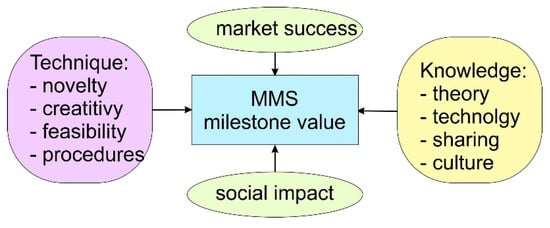
Figure 8.
A scheme for milestone values of MMS achievements.
In addition to technique merits, milestone values in achievements and people can be identified by the significance and impact on the larger public. Public understanding and appreciation can be achieved with exhibitions of those achievements as tangible products of cultural heritage value. In the case of people, their contributions as intangible characters can be understood and appreciated by the influential legacy that they have left in the evolution of specific fields.
In the specific case of MMS milestones, specific technical content refers to machines and mechanisms as related to the topics that contributed to developments in mechanical engineering, through achievements by figures and community in those specific topics. The cultural value in MMS milestones can be evaluated referring to criteria as summarized in Figure 8, when considering evaluation of technical impacts in theoretical aspects, design issues, and applications. As stressed in Figure 8, technical aspects and knowledge values are considered together, with results on market valorization and social acceptance, in order to demonstrate practical success of an achievement or figure.
Technical merits can be summarized in aspects that are related to:
- Novelty, referring also to originality, when a milestone product was conceived and proposed, with new features referring to new concepts and solutions;
- Creativity, when a milestone product was obtained from creative activity;
- Feasibility, when a milestone product was applied efficiently with technical acceptance;
- Procedures with technical impacts, when a milestone product improved technical practices and applications.
Merits on knowledge acquisition can be summarized in aspects that are related to:
- Theory news, when a milestone product was a theoretical advance even producing further MMS developments;
- Technological transfer, when a milestone product produced a technical dissemination of achievements within designer/inventor communities;
- Dissemination, when a milestone product was disseminated producing further knowledge acquisitions and achievements;
- Cultural impact, when a milestone product affected cultural aspects at large with the innovation characters that have been fully accepted by users in the society.
The MMS products with milestone significance in technical achievements can be not only in machine designs and machinery constructions with physical remains, but even in knowledge and procedures used in conception, design, and production. As per Italian machinery milestone identification, attempts have been produced only recently, as reported in [], as the example referring to the engine mechanism collection at the University of Palermo [], and with an international recognition of the ASME landmark program.
All the above-mentioned considerations can be addressed to the models of mechanism with cultural heritage value, referring to their tangible and intangible contents. Therefore, mechanism models, in any of their formats, can be suitable and valuable for museum valorization, far more than is offered today, with only a few examples exhibited as an attraction of past technology.
6. Mechanism Models in Italian Universities
In this section, examples of mechanism models with their values are discussed to illustrate the Italian collections still existing with those values of cultural heritage products, but also as a useful means for teaching and design purposes. The reported examples are selected from the main Italian universities where collections of mechanical models, mainly from 19th century, are still preserved with some attention (poor or not) to their preservation and fruition, very often even with no archival data. The reported examples want to emphasize aspects and problems referring to the valorization of the physical models of mechanisms used in the past, and even recently, starting from an analysis of the state of conservation and consideration of the frames of their current preservation and use.
6.1. An Illustrative Example: The Models at the Engineering School in Rome
The images in Figure 9 show how the models of mechanisms remaining in the department, now called Mechanics and Aeronautics, are preserved, a tradition probably originating from the 1930s. The models, of which the few examples that remain are wooden models, were designed and built by the course teachers on Mechanics Applied to Machines for teaching and explaining both the functional design and the operation of the reproduced mechanisms. The preservation of these mechanisms in the two cabinets shown in the image has been provisional since the 1970s, when Professor Scotto Lavina, the last teacher to use them, retired at the end of the 1980s. In reality, these models were complemented by graphic tables, unfortunately lost, were large in size with construction details and sketches of models for design calculations, and with practical constructions that were jointly explained with the corresponding wooden model. As can be seen from the images in Figure 9, the models today have no use, and are practically forgotten without even having an historical display usefulness for teaching; posters and announcements relating to other departmental initiatives are also often posted, so that they completely obscure the visibility of the models and contents in the cabinets.
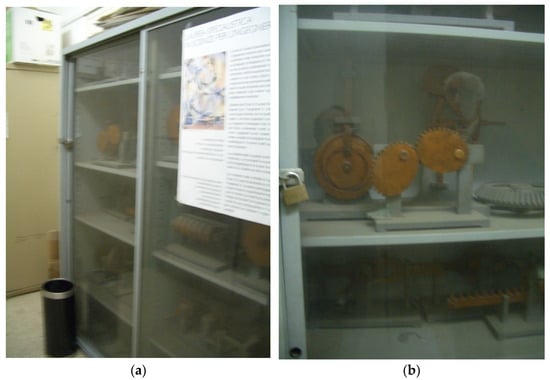
Figure 9.
Frame of today’s storage of wood models at the Department of Mechanics and Aeronautics in Rome: (a) the storage wardrobe; (b) zoomed view of the storage within the wardrobe.
The examples shown in Figure 10 show two wooden models of excellent workmanship, probably built in the years 1950–1960, to explain the fundamental constructive elements of gear transmission in the two cases of rotary motion and rectilinear motion, coming from a toothed wheel pinion. The running of the models is ensured by a special crank that a user can easily rotate to not only move the transmission components, but also to have a direct experience of mechanics in the operation of gear transmission components, in terms of motion and force. The dimensions of the two specimens with wheels are about 20–30 cm in diameter, while the linear rod with rungs has a size of about 40 cm, to also indicate a realistic mechanical design with organs applicable to industrial-type machines. These two specimens, like others crammed into the cabinets of Figure 9, can be appreciated both at the construction level in terms of manufacturing wooden models for teaching, but also at the level of the history of teaching, with a value that could still be useful today to show students the essential aspects of gear transmission.
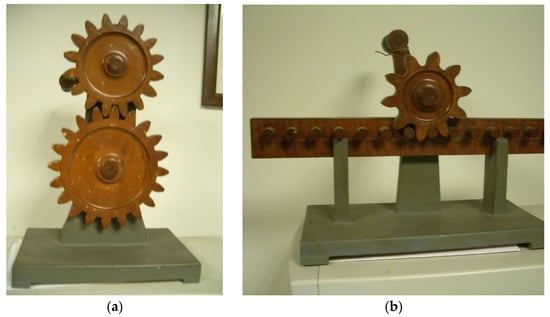
Figure 10.
Examples of wood models stored as in Figure 9: (a) two-circular gear transmission; (b) gear-rack transmission.
The last example of Figure 11 shows a very small-scale model of an industrial crane, made with essential components in terms of both structure, and components for the transmission of power necessary for the application purpose. The model is made with metal elements and with bronze gear wheels to denote the attention to detail of the functionality of the model, which is also completed by suitable ropes for a hoist application. This model appears to have been built in the 1970s, perhaps more for research needs or even better as a scale model for design purposes, even if it seems to have been used for didactic purposes, limited to the use of a few students with thesis work. This example is significant to represent how a combined physical model with metal and wooden elements, even in modern times, has useful and interesting results from various technical-scientific aspects, but also from a historical point of view, it shows how design and research activities were accompanied with functional and detailed physical models.
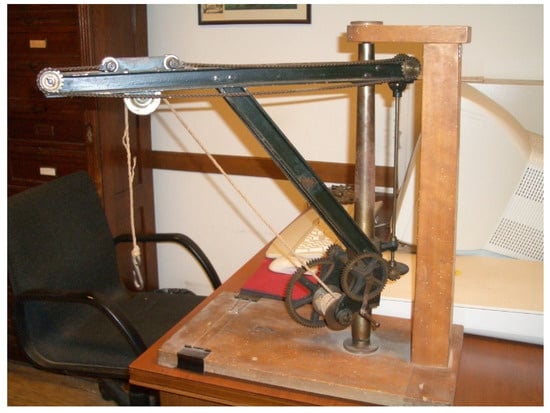
Figure 11.
An example of an industrial-like crane model stored as in Figure 9.
Very likely, in other departments or warehouses of the engineering faculty of the University of Rome, one could find other physical and paper models used for the explanation and teaching of the mechanisms of the machines, as well as models used in research and applied design for what was taught and investigated for the development of machines, in both more efficient and traditional applications.
6.2. An Illustrative Example: The Models at the Engineering School in Bologna
The Department of Industrial Engineering of the University of Bologna has a collection of 53 models of mechanisms, largely from 20th century, for didactic purposes, that are stored in two cabinets, as shown in Figure 12.
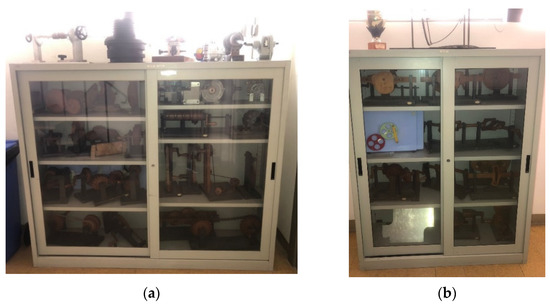
Figure 12.
The collection of models of mechanisms at the Department of Industrial Engineering at the University of Bologna: (a) main wardrobe; (b) secondary wardrobe.
At present, the models are no longer used for teaching but are kept in two cabinets with sliding glass doors, arranged in the entrance corridor, so that a student or visitor who enters the section of Mechanics Applied to Machines can look at them. The storage in the cabinets is not functional for museum purpose: the models are arranged in several overlapping rows, due to the limited space, and there are no descriptive plates. The collection is divided into 34 models in wood, nine in plastic and 10 in metal.
The wooden models follow the classification of the Reuleaux mechanisms, but the construction is that of the tables shown in Masi’s book, as shown in Figure 2, with the comparison between the real model and the image in his book []. We can therefore date the collection to the teaching period of Francesco Masi (1889–1927) at the University of Bologna, or Modesto Prosciutto (1927–1954), the one immediately after. More likely, they date back to the early twentieth century, considering the importance of experimental applications in Masi’s teaching [,]. The wooden models mainly concern gear wheels, cams, pulleys, chains, and joints.
As an example, Figure 13 shows an eccentric mechanism with several lobes. This mechanism–the most famous is the heart-shaped cam-has the property of having all its diameters of constant length, as evidenced by the diameters drawn on the front, and easily measurable. For this property, the eccentric can be closed within a frame between two wheels, the centers of which are placed at a distance equal to the diameter of the primitive curve of the eccentric. The model is mounted on a 40 × 20 cm base and has a height of approximately 25 cm. On the back there is a crank to rotate the cam manually, and to move the reciprocating rectilinear motion rod. On the back of the cam, “Scuola d’applicazione per gli ingegneri in Torino. Blotto Giovanni meccanico” (Application school for engineers in Turin. Blotto Giovanni mechanic) is engraved, but not the production date. Giovanni Blotto, model maker, was an assistant at the University of Turin, and together with Vittorio Canepa he created a large collection of models at the request of Giovanni Curioni, Professor of Construction at the Application School of Turin []. Subsequently, Blotto and Canepa opened a model-making company for didactic equipment, to which the models from the Bolognese collection were probably commissioned (other examples of Blotto and Canepa’s models can be found at the University of Naples “Federico II” []).
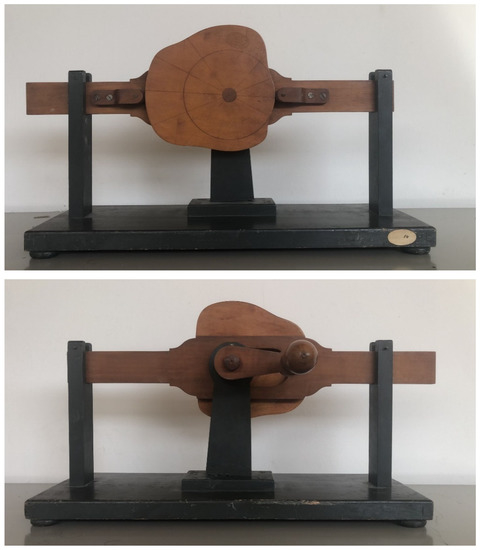
Figure 13.
Front and rear view of a multilobes cam that transforms the rotation of the input cam into and alternative motion of the rod.
The plastic models were made during the period of activity of Funaioli, in the 1980s, and concern plane kinematics. The different colors highlight the different parts of the mechanism, and engravings on the base highlight the trajectory traveled by the kinematic pairs. Figure 14 shows a four-bar linkage, in which the intermediate connecting rod (green) is the driver and is actuated by means of a gear (red). On the base (blue) there is an engraving depicting the maximum angular excursion of the rocker (white). The base of the model has dimensions 40 × 30 and there are feet to be able to place it vertically. On the back there is the manufacturer’s label: “Institut für landtechnische grundlagenforschung model. Braunschweig-Völkenrode”. This label suggests that the models were a gift from a visiting professor (or another meeting occasion between the Italian and German research groups). One of the authors saw similar models in the office of Hanfreid Kerle at the Technical University of Braunschweig, which belonged to the previous Hoecken’s collection []. It should be emphasized that on both types of model there are consecutive numbers, which suggest a much larger collection than the one currently left.
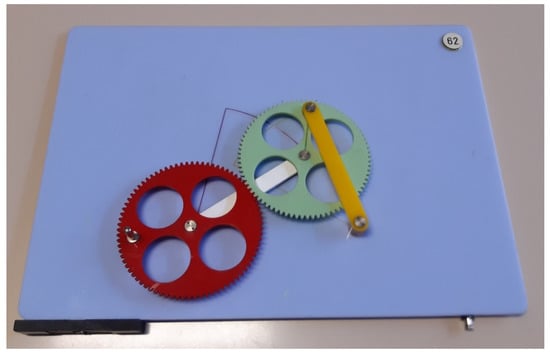
Figure 14.
Four-bar linkage mechanism with an actuated connection rod and the maximum angular displacement of the rocket engraved on the base.
All the pieces are in an excellent state of conservation, and they fascinate anyone who passes in front of the cabinets. The value of these pieces is not only historiographical, but above all, didactic. Even today they can be used to clarify the functioning of complex mechanisms, and help future engineers to assimilate the concepts of machine mechanics.
6.3. An Illustrative Example: The Models at the Engineering School in Turin
The collection of mechanisms in the Polytechnic of Turin is stored in various cabinets in the meeting room of the Department of Mechanical and Aerospace Engineering, Figure 15, for preservation purposes and only recently with an attempt to re-evaluate both teaching and museum valorization, as reported in [].
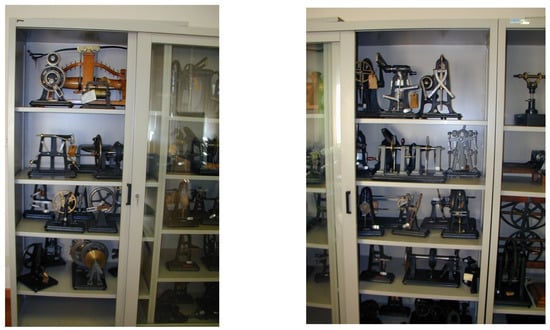
Figure 15.
The collection of models of mechanisms at the Department of Mechanical and Aerospace Engineering at the Polytechnic of Turin.
The collection is of more than 100 specimens of various sizes and various mechanisms, with constructions of different materials including both acquired models and models designed and built in-house. Unfortunately, as with other collections in academic institutions, there is no compilation of archival data that can uniquely identify the period and authors of many of these models, excluding those that with their own tags give specific indications on the origin and construction of the model. Most of the models have been acquired from the Schröder-Reuleaux commercial collection, such as [], to which many of the later models actually refer both in terms of structure and design. Each Schröder-Reuleaux model is provided with a small plate with the Schröder company logo, and its corresponding catalog number.
A reusage of some models in teaching activity started in 2015, by planning three hours using a few of those models in combination with numerical computer-assisted procedures in a didactic laboratory, for the second-year course of Automatic Machine Mechanics in the MSc in Mechanical Engineering program, which involves the use of historical models of basic mechanisms.
Figure 16, Figure 17 and Figure 18 are illustrative examples of the above-mentioned variety. In particular, Figure 16 shows a metallic model of hypoid connections that represents both the concepts of screw (helicoidal) motion and hypoid gear design. The model looks to be built and functioning for theoretical purposes, with a robust design on a wood plate of about 80 × 40 cm that, very likely made in Turin, was supposed to be movable by lost cranks in the circular wheel extremities.
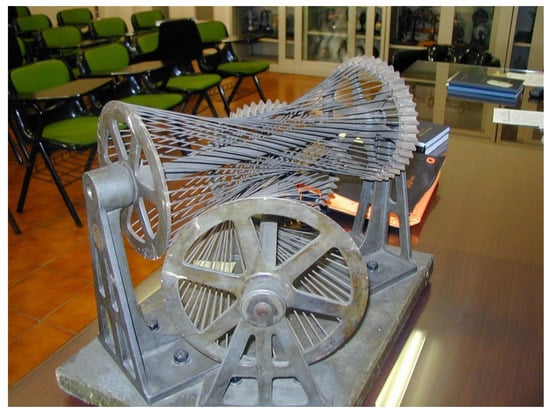
Figure 16.
The iron-made model of the hypoid connections representing the screw motion and hypoid gears.
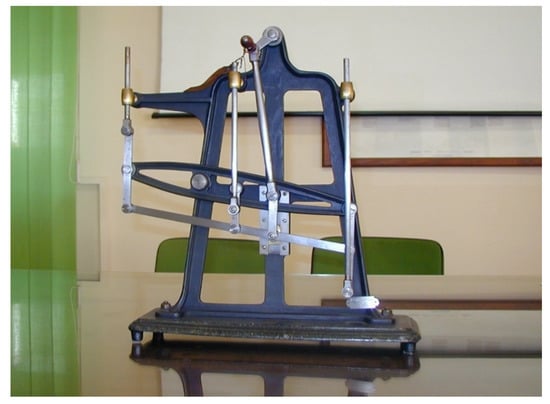
Figure 17.
The iron-made model the Watt linkage for approximate-line guide.
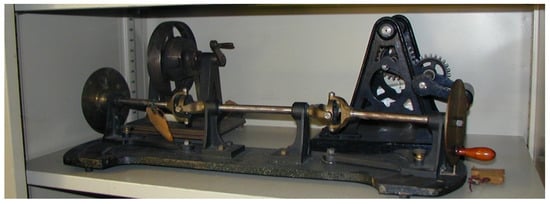
Figure 18.
The iron-made model of axle transmission with Cardan joints.
Figure 17 shows the Watt mechanism, with construction details in its approximate linear guide function using metal elements, being a mechanical model of an improved mechanism from a specimen from the commercial Schröder-Reuleaux collection. Also in this case, the implementation of the mechanism is obtained by means of a small crank, which allows a user not only to manage the functioning of the mechanism but also to have feedback in terms of mechanical efficiency during operation. Finally, of note is the valuable workmanship that makes the model an historical piece of high interest for a museum valorization as it is linked not only to the history of steam engines and the mechanisms used in them, but also for specific interest in the production of these mechanical models.
Figure 18 shows two characteristic aspects of the preservation of the models in the Italian engineering schools, considering the fact that the models are crammed together without a suitable space between them, which not only prevents possible use, but does not allow complete visibility of each model. In addition, the models built in the offices are considered in the same way as those coming from external purchase, such as those from the Schröder-Reuleaux collection. In particular, Figure 18 shows at its front view the model of a Cardan transmission with torsion rods, with an assembly combining bronze elements with steel rods on cast iron supports, which can be oriented on a wood platform. In addition, in this model the functionality and efficiency of the mechanism is obtained with the action of a user through a crank on the input disk, for the rotation of the initial shaft, which allows a visualization and quantification of the efficiency of the motion transmission by another disk on the last rod of the transmission. It should also be noted that this model hides two other models of exquisite workmanship, and of considerable interest, for the structure of the mechanisms: the first, on the left, is a belt transmission with flywheel, and the second is a gear train, not completely visible even for the structure on which the gears are keyed. The first of these two models look like a model built in-house when you also notice the manufacturing of the operating crank of the mechanism, while the second is a product of the Schröder-Reuleaux collection.
6.4. An Illustrative Example: The Models at the Engineering School in Milan
The collection of models preserved at the Department of Mechanics of the Politecnico di Milano, is an emblematic example of how much the historical value and interest of such models can be also suitable to outline the historical development of the discipline and institutions, as reported and emphasized in the publications of historical celebrations of the department in [,]. The collection is preserved mainly with models made in the 1920s–1950s, especially by the work and use of Professor Ottorino Sesini (who retired in 1962) and his successors. Previous acquisitions and constructions remain missing, with some surviving thanks to the historical didactic interest of some teachers, such as those of the publications cited [,]. Unfortunately, despite having such recognized historical value, the collection is not usable, but remains preserved as a set of historical memorabilia of the department, especially with regard to past didactic activities. Many of the models which survived the time, were made in the Laboratory of the Society of Encouragement of Arts and Crafts, Milan, following the instruction of teachers for their teaching activities on Kinematics and Design of mechanisms, and in aspects related to the Drawing of machines, in a similar way to what was in use in other Italian academic centers, but also in Europe, at the end of the 19th century. Many of the remaining models, of which examples are shown in Figure 19, are made with steel and bronze elements mounted on a wooden base, with dimensions for easy portability and functionality suitable for use by students for mechanical efficiency with low friction. The examples of Figure 19 refer to the variety of crank-slider mechanisms, useful for the transformation of the continuous rotary motion into an alternative translation, or vice versa. Of note is the essential structure of the models to indicate and realize the functionality of the mechanism, as combined with a practical construction useful for easy portability (both in theory classes and in laboratory sessions), as well as the elegant workmanship that still today makes them attractive both for future re-evaluation in didactic activities, and for a concrete museum valorization.
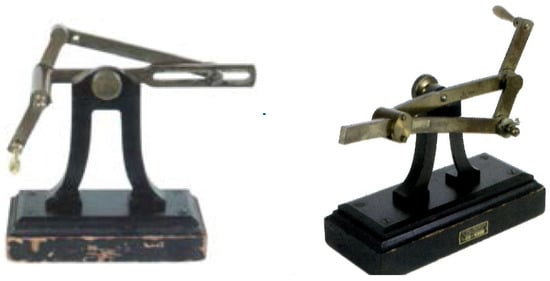
Figure 19.
Examples of the iron-made crank-slider mechanism models from the 1930s’ within the collection at the Department of Mechanics, Milan.
6.5. An Illustrative Example: The Models at the Engines Museum in Palermo
The Palermo collection, including models of mechanisms and restored working engines [], is a valuable example of museum valorization of recognized prestige, even with an international award such as the ASME Landmark prize []. The collection is presented with an emphasis on engines, starting with steam engines of the 19th century up to experimental engines in the aeronautical fields that have been developed over time in other locations and in industrial productions, but used in the laboratories of the University of Palermo for research. Remarkable to remember is the commitment and the activity carried out in restoring those engines and the models of mechanisms, for their recovery not only in the structure but mainly in the functionality of a clear museum display, and an efficient presentation from an engineering viewpoint, and for educational purposes, that are limited to the rooms of the museum. The models of the mechanisms refer to a collection started by Professor Ovazza in the early years of the 20th century, with models acquired and built similar to those present at the Polytechnic of Turin, his academic site of origin. They were then enriched with models of local construction in Palermo by his successors, until reaching the collection in the 1970s. After a period of abandonment, both the collection of mechanisms and the engines received deserving renewed interest; the museum was founded and specifically dedicated to this museum valorization.
Figure 20, Figure 21 and Figure 22 show illustrative examples of the museum arrangement, and the rich collection that the museum houses both in internal combustion and steam engines, and in models of mechanisms. In particular, although the models of the mechanisms are arranged with appropriate open display cabinets, they can be available for interactive use by visitors and students, with an appreciable way of direct experience on the functionality of the models.
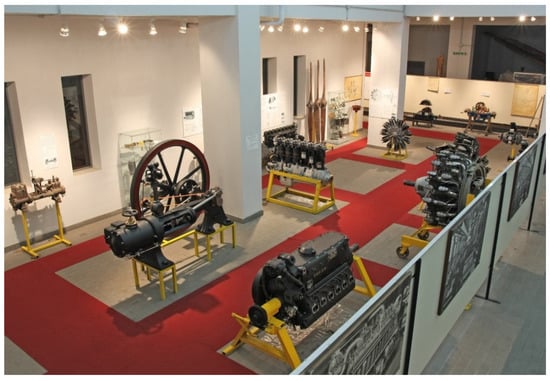
Figure 20.
A view of the main exhibition room of the Museum of Engines and Mechanisms at University of Palermo, with engines form several periods and several applications.
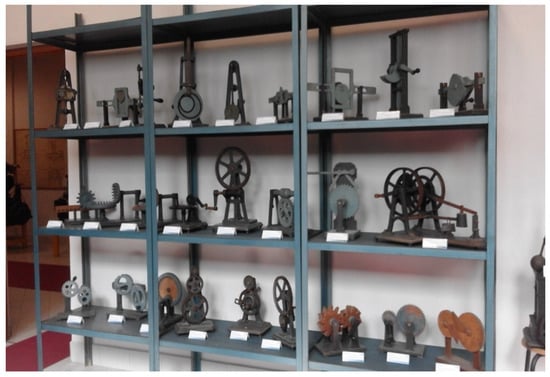
Figure 21.
A cabinet with open-air exhibition of mechanism models in a museum room specifically dedicated to the models for teaching.
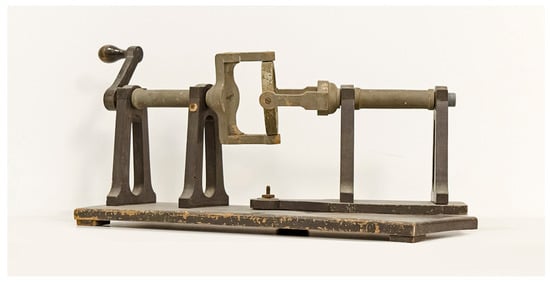
Figure 22.
An example of the on-site built mechanism models at University of Palermo.
In particular, Figure 20 shows a panoramic view of the main museum itinerary, hosting a variety of internal combustion engines and the first steam engines, with a clearly indicated route to facilitate a visitor, according to the historical development of the engines on display, many of which function with the help of a modern electric actuation system.
Figure 21 shows the main exhibition frame for the models of the mechanisms, housed in a special room containing about 100 models of mechanisms of various manufacturing, size, and functionality, as collected over time with elements both acquired from commercial and other productions by academic bodies, as well as models built at the laboratory of the University of Palermo.
In Figure 21, it is possible to see several mechanisms that can be used, and were used, to explain the possibilities of mechanisms in the conversion of motion, and in the structure of the machines as already represented in the collections previously discussed. There are wooden models probably built in-house, according to the needs and instructions of the teachers of the time, as well as by the availability of manufacturing and budget, just as there are metal models of commercial collections, also built in-house to indicate the possibility of design and prototyping of the models themselves. Figure 22 shows an original model of the collection, with a structure that can be recognized as common to commercial-type models, such as the one shown by the Turin collection in Figure 18.
Figure 22 is an example of how the models have been duplicated with constructions in local frames, as the example of the figure represents the model of a rod transmission with Cardan joints, also present in the Turin collection. What is shown in Figure 22 is an example built with a design for compact dimensions, in materials typical of industrial applications for naval transmissions, and placed on a wooden base with one movable support; this is different from what is seen in the model shown in Figure 18, but it somehow has a more evident and appreciable effect.
The experience of the museum valorization in Palermo can be considered an emblematic example of how it is possible to valorize technical and scientific content, and also the historical value of the models of mechanisms, combined with applications of complete and perhaps more significant machines, such as the engines that are indicated as the main purpose of the museum. Moreover, the experience of the Palermo Museum shows how such models can have a value not only as cultural heritage, but as an interest and applicability in explanatory activities for visitors, in addition to having an educational purpose for engineering students.
7. Conclusions
This paper presents aspects and problems for didactic and technical-scientific reconsideration of the models of mechanisms, especially in the format of a scaled mechanical structure for the purpose of an historical valorization for one’s own awareness, and use in the formation and tracing of the history of Italian mechanical engineering. The examples that are reported from the major Italian academic sites refer to collections present in some of the major universities, with preservation and archiving solutions and use modalities that give hope for an adequate, especially historical, valorization of cultural heritage. The models of the mechanisms, which historically have evolved from graphic representations to constructions with mechanical structure, right up to today’s virtual solutions, have an importance not always recognized both at the didactic and design level with aspects that, however, lead back to the development of mechanical engineering, with content worthy of preservation as cultural heritage. The models in Italian universities have this aspect of cultural heritage, being adequately preserved for historical interest, with models purchased both outside the academic site and produced on site, helping students in research and design activities. The discussed examples show the variety of solutions in terms of mechanisms, and constructive solutions in materials and functionalities, with a richness yet to be fully discovered in Italian academic centers.
Funding
This research received no external funding.
Institutional Review Board Statement
Not applicable.
Informed Consent Statement
Not applicable.
Conflicts of Interest
The authors declare no conflict of interest.
References
- Singer, C.; Holmyard, E.J.; Hall, A.R.; Williams, T.I. History of Technology; Bollati Boringhieri: Turin, Italy, 2012; Volume 2. (In Italian) [Google Scholar]
- Capocaccia, A. (Ed.) History of Technique—From Prehistory to the Year One Thousand; UTET: Turin, Italy, 1973. (In Italian) [Google Scholar]
- Nolle, H. Linkage Coupler Curve Synthesis: A Historical Review—I and II; Mechanism and Machine Theory; Elsevier: Oxford, UK, 1974; Volume 9. [Google Scholar]
- Kerle, H.; Mauersberger, K.; Ceccarelli, M. Historical Remarks on Past Model Collections of Machines and Mechanisms in Europe. In Proceedings of the 13th World Congress in Mechanism and Machine Science IFToMM 2011, Guanajuato, Mexico, 19–23 June 2011. paper n. A21-279. [Google Scholar]
- Reuleaux, F. Theoretische Kinematik; F. Viewg und Sohn: Braunschweig, Germany, 1875. [Google Scholar]
- Voigt, G. Kinematische Modelle nach Professor Reuleaux, catalogue I and II; Voigt: Berlin, UK, 1907. [Google Scholar]
- TU Dresden, Collection of Mechanism and ger Models. Available online: https://tu-dresden.de/kustodie/sammlungen-kunstbesitz/ingenieurwissenschaften/getriebemodell-sammlung?set_language=en (accessed on 1 June 2022).
- Golovin, A.; Tarabarin, V. Russian Models from the Mechanisms Collection of Bauman University; Springer: Dordrecht, The Netherlands, 2008. [Google Scholar]
- Ceccarelli, M. A historical account on Italian mechanism model. Elementa. Intersect. Between Philos. Epistemol. Empir. Perspect. 2021, 1, 115–134. [Google Scholar] [CrossRef]
- Ceccarelli, M. Figures and achievements in MMS as landmarks in history of MMS for inspiration of IFToMM activity. Mech. Mach. Theory 2016, 105, 529–539. [Google Scholar] [CrossRef]
- ASME History and Heritage Committee (Ed.) Landmarks in Mechanical Engineering; Purdue University Press: West Lafayette, India, 1997. [Google Scholar]
- Black, J.M. Machines That Made History—Landmarks in Mechanical Engineering; ASME Press: New York, NY, USA, 2014. [Google Scholar]
- Ceccarelli, M. Are Theory and Procedures for Mechanism Designs Suitable as Goods of Cultural Heritage? Rev. Int. Estud. Vascos 2014, 59, 36–50. [Google Scholar]
- IFToMM. Special Issue: Standardization and Terminology. In Mechanism and Machine Theory; No. 7–10; Elsevier: Oxford, UK, 2003; Volume 38. [Google Scholar]
- Uicker, J.J.; Pennock, G.R.; Shigley, J.E. Theory of Machines and Mechanisms; Oxford University Press Inc.: Oxford, UK, 2017. [Google Scholar]
- Lopez-Cajùn, C.S.; Ceccarelli, M. Mechanisms: Fundamentals of Kinematics for Design and Optimization of Machinery, 2nd ed.; Trillas: Mexico City, Mexico, 2013. (In Spanish) [Google Scholar]
- Ceccarelli, M. Models of mechanisms for teaching and experimental activity. In Proceedings of the Atti del XXXVIII Convegno annuale Società Italiana degli Storici della Fisica e dell’Astronomia, Messina, Italy, 3–6 October 2018; Pavia University Press: Pavia, Italy, 2018; pp. 255–266, ISBN 978-88-6952-7. [Google Scholar]
- Ceccarelli, M. An Outline of History of Mechanism Design in servicing Science. In Physics, Astronomy and Engineering: Critical Problems in the History of Science and Society, Proceedings of the 32nd International Congress of the Italian Society of Historians of Physics and Astronomy, Rome, Italy, 27–29 September 2012; Scientia Socialis Press: Šiauliai, Lithuania, 2012; pp. 1–10. ISBN 978-609-95513-0-2. [Google Scholar]
- Ceccarelli, M.; Cigola, M. On the evolution of graphical representation of gears. In Proceeding of the Conference MeTrApp 2011 Mechanisms, Transmissions, Applications; Book Series on Machines and Machine Science; Springer: Dordrecht, The Netherlands, 2011; Volume 1, pp. 3–14. [Google Scholar]
- Ceccarelli, M. Short History of Mechanics of Machinery in Italy. In Proceedings of the 5th Italian Conference on History of Engineering; Cuzzolin Publ.: Napoli, Italy, 2014; pp. 87–102. (In Italian) [Google Scholar]
- Rossi, C.; Ceccarelli, M. Science, Technology and Industry in Southern Italy Before the Unification. In Essays on the History of Mechanical Engineering, History of Mechanism and Machine Science 31; Springer: Dordrecht, The Netherlands, 2016; pp. 159–180. [Google Scholar] [CrossRef]
- Ceccarelli, M. Giuseppe Antonio Borgnis (1781–1863). In Distinguished Figures in Mechanism and Machine Science—Part 3, History of Mechanism and Machine Science Volume 26; Springer: Dordrecht, The Netherlands, 2014; pp. 41–56. [Google Scholar] [CrossRef]
- Giulio, C.I. Lezioni di Meccanica Applicata alle Arti; Tipografia Pomba: Torino, Italy, 1846. [Google Scholar]
- Giorgini, G. Intorno alle Proprietà Geometriche dei Movimenti di un Sistema di Punti di Forma Invariabile; Memorie di Matematica e Fisica della Società Italiana delle Scienze; Tomo XXI; Tipografia Camerale: Modena, Italy, 1836; pp. 1–54. [Google Scholar]
- Ceccarelli, M.; Sorge, F.; Genchi, G. Elia Ovazza: Professor of TMM in Palermo around the End of the 19th Century. In Essays on the History of Mechanical Engineering, History of Mechanism and Machine Science 31; Springer: Dordrecht, The Netherlands, 2016; pp. 47–64. [Google Scholar] [CrossRef]
- Fang, Y.; Ceccarelli, M. Medium Size Companies of Mechanical Industry in Northern Italy during the Second Half of the 19th Century. In Essays on the History of Mechanical Engineering, History of Mechanism and Machine Science 31; Springer: Dordrecht, The Netherlands, 2016; pp. 181–200. [Google Scholar] [CrossRef]
- Ceccarelli, M. ‘Francesco Masi (1852–1944)’. In Distinguished Figures in Mechanism and Machine Science: Their Contributions and Legacies—Part 2, Book Series on History of Machines and Machine Science; Springer: Dordrecht, The Netherlands, 2010; Volume 7, pp. 141–162. ISBN 978-90-481-2345-2. [Google Scholar] [CrossRef]
- Allievi, L. Cinematica della Biella Piana; Regia Tipografia Francesco Giannini & Figli: Napoli, Italy, 1895. (In Italian) [Google Scholar]
- Ceccarelli, M.; Koetsier, T. Burmester and Allievi: A Theory and Its Application for Mechanism Design at the End of 19th Century. J. Mech. Des. 2008, 130, 072301. [Google Scholar] [CrossRef]
- Ceccarelli, M. Allievi Lorenzo (1856–1941). In Distinguished Figures in Mechanism and Machine Science—Part 3, History of Mechanism and Machine Science Volume 26; Springer: Dordrecht, The Netherlands, 2014; pp. 1–17. [Google Scholar] [CrossRef]
- Ceccarelli, M.; Teoli, G. Corradino D’Ascanio and His Design of Vespa Scooter. In Multibody Mechatronic Systems, Mechanisms and Machine Science 25; Springer: Dordrecht, The Netherlands, 2015; pp. 399–410. [Google Scholar] [CrossRef]
- Cocconcelli, M. The Teaching of Applied Mechanics through Textbooks in Italy. Adv. Hist. Stud. 2020, 9, 358–376. [Google Scholar] [CrossRef]
- Reuleaux, F. Lehrbuch der Kinematic; F. Vieweg und Sohn: Braunschweig, Germany, 1900. [Google Scholar]
- Masi, F. Manuale di Cinematica Applicata: Nuova Classificazione dei Meccanismi; Zanichelli: Bologna, Italy, 1883. [Google Scholar]
- Masi, F. La Teoria dei Meccanismi; Zanichelli: Bologna, Italy, 1897. [Google Scholar]
- Ceccarelli, M. Classifications of mechanisms over time. In Proceedings of International Symposium on History of Machines and Mechanisms HMM2004; Kluwer: Dordrecht, The Netherlands, 2004; pp. 285–302. [Google Scholar]
- Museum of Engines and Mechanisms, Engine of Innocenti Lambretta 125 C; University of Palermo: Palermo, Italy. Available online: https://www.museomotori.unipa.it/scheda.php?id=40 (accessed on 1 June 2022).
- Corazzari, L.; Di Felice, E.; Mucchi, E. Design and Construction of 3-Step Gear by 3D Printing. Master’s Thesis, University of Ferrara, Ferrara, Italy, 2019. (In Italian). [Google Scholar]
- Bellinazzi, T.; Mucchi, E. Design and Construction of a V8 Engine by 3D Printing. Bachelor’s Thesis, University of Ferrara, Ferrara, Italy, 2020. (In Italian). [Google Scholar]
- UNESCO. Cultural Heritage-2010. Available online: http://portal.unesco.org/culture/ (accessed on 11 October 2013).
- Ceccarelli, M. Considerations on Mechanism Designs as Suitable for Cultural Heritage Evaluation. Adv. Hist. Stud. 2013, 2, 175–184. [Google Scholar] [CrossRef][Green Version]
- ASME History and Heritage Committee (Ed.) About the Landmarks Program. Available online: https://www.asme.org/about-asme/engineering-history/landmarks/about-the-landmarks-program (accessed on 19 May 2022).
- Ceccarelli, M. Italian Landmarks in the History of MMS. In Proceedings of the 2015 IFToMM Workshop on History of Mechanism and Machine Science, St-Petersburg, Russia, 26–28 May 2015. paper no. 20-03. [Google Scholar]
- ASME. A Historic Mechanical Engineering Collection: The Collection of Engines at the Museum of Engines and Mechanism of University of Palermo, Palermo; Museum Brochure; ASME: New York, NY, USA, 2017. [Google Scholar]
- Ceccarelli, M.; Molari, P.G. Come insegnare la meccanica. Il metodo di Francesco Masi all’Università di Bologna e all’Istituto Aldini Valeriani. Riv. Sc. Off. 2016, 2, 4–11. [Google Scholar]
- Gianasso, E. Cultura e formazione degli ingegneri. Studi ottocenteschi intorno a Leonardo da Vinci. In Proceedings of the 4th International Conference on History of Engineering, Naples, Italy, 11 December 2020; pp. 511–522. [Google Scholar]
- Università Degli Studi di Napoli “Federico II”, I Modelli Didattici Conservati Presso il Centro Interdipartimentale di Ingegneria per i Beni Culturali. Available online: http://www.nordsud.unina.it/storia_ing/interna11-b.html (accessed on 1 June 2022).
- Kerle, H. About Karl Hoecken and some of his works on mechanisms. In Explorations in the History of Machines and Mechanisms: Proceedings of HMM2012; Springer: Dordrecht, The Netherlands, 2012; pp. 123–134. [Google Scholar]
- Franco, W.; Trivella, A.; Quaglia, G. Mechanism and Machine Science Educational Workshop Based on Schröder-Reuleaux Ancient Models of Politecnico di Torino. Adv. Hist. Stud. 2020, 9, 295–311. [Google Scholar] [CrossRef]
- De Alberti, L.; Rovida, E. (Eds.) Historical Heritage of Mechanics Department; Politecnico di Milano: Milan, Italy, 1999. (In Italian) [Google Scholar]
- Curami, A.; Rovida, E.; Zappa, E. Mechanics Teachers Since 1863: History of Mechanics Department; Politecnico di Milano: Milan, Italy, 2015. (In Italian) [Google Scholar]
- Monastero, R.; Genchi, G. The Museum of Engines and Mechanisms. More Than a Century of History of Technology. In Essays on the History of Mechanical Engineering. History of Mechanism and Machine Science, Volume 31; Sorge, F., Genchi, G., Eds.; Springer: Cham, Switzerland, 2016; pp. 201–225. [Google Scholar] [CrossRef]
- Genchi, G. (Ed.) The Collection of Engines at the Museum of Engines and Mechanisms University of Palermo—A Mechanical Engineering Heritage Collection for ASME Landmark; Museum of Engines and Mechanisms, University of Palermo: Palermo, Italy, 2017. [Google Scholar]
Publisher’s Note: MDPI stays neutral with regard to jurisdictional claims in published maps and institutional affiliations. |
© 2022 by the authors. Licensee MDPI, Basel, Switzerland. This article is an open access article distributed under the terms and conditions of the Creative Commons Attribution (CC BY) license (https://creativecommons.org/licenses/by/4.0/).